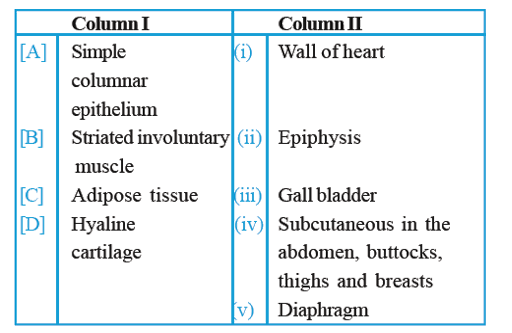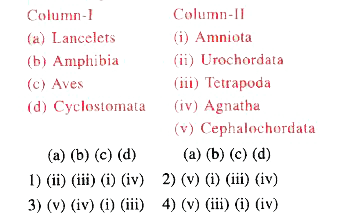Match column I with column II and select the correct option from the codes given below.
Column IColumn IIA. PCT(i). Minimum reabsorptionB. DCT(ii). Filtration of bloodC. Loop of Henle(iii). Reabsorption of 70-80% electrolytesD. Counter current mechanism(iv). Ionic balanceE. Renal corpuscle(v). Maintenance of concentration gradient in medulla
a) A-(iii),B-(iv),C-(i),D-(v),E-(ii)
b) A-(iii),B-(v),C-(iv),D-(ii),E-(i)
c) A-(i),B-(iii),C-(ii),D-(v),E-(iv)
d) A-(iii),B-(i),C-(iv),D-(v),E-(ii)
The correct Answer is:A
To match the items from Column I with those in Column II, we will analyze each item in Column I and determine the correct corresponding item in Column II based on the functions of each nephron component.
1. Identify the function of PCT (Proximal Convoluted Tubule):
- The PCT is responsible for the reabsorption of approximately 70-80% of electrolytes and water from the filtrate back into the blood.
- Match: PCT → (iii) Reabsorption of 70-80% electrolytes.
2. Identify the function of DCT (Distal Convoluted Tubule):
- The DCT plays a significant role in ionic balance and is involved in the reabsorption of sodium and the secretion of potassium and hydrogen ions, thus maintaining acid-base balance.
- Match: DCT → (iv) Ionic balance.
3. Identify the function of the Loop of Henle:
- The Loop of Henle is primarily involved in the concentration of urine and reabsorbs a smaller amount of water and electrolytes. It is not primarily known for significant reabsorption but rather for creating a concentration gradient.
- Match: Loop of Henle → (i) Minimum reabsorption.
4. Identify the function of the Counter Current Mechanism:
- The counter current mechanism is crucial for maintaining the concentration gradient in the renal medulla, which allows for the efficient reabsorption of water in the collecting ducts.
- Match: Counter Current Mechanism → (v) Maintenance of concentration gradient in medulla.
5. Identify the function of the Renal Corpuscle:
- The renal corpuscle, which consists of the glomerulus and Bowman's capsule, is primarily responsible for the filtration of blood to form urine.
- Match: Renal Corpuscle → (ii) Filtration of blood.
Final Matches:
- A → (iii) Reabsorption of 70-80% electrolytes
- B → (iv) Ionic balance
- C → (i) Minimum reabsorption
- D → (v) Maintenance of concentration gradient in medulla
- E → (ii) Filtration of blood
Summary of Matches:
- A - iii
- B - iv
- C - i
- D - v
- E - ii
- The PCT is responsible for the reabsorption of approximately 70-80% of electrolytes and water from the filtrate back into the blood.
- Match: PCT → (iii) Reabsorption of 70-80% electrolytes.
- The DCT plays a significant role in ionic balance and is involved in the reabsorption of sodium and the secretion of potassium and hydrogen ions, thus maintaining acid-base balance.
- Match: DCT → (iv) Ionic balance.
- The Loop of Henle is primarily involved in the concentration of urine and reabsorbs a smaller amount of water and electrolytes. It is not primarily known for significant reabsorption but rather for creating a concentration gradient.
- Match: Loop of Henle → (i) Minimum reabsorption.
- The counter current mechanism is crucial for maintaining the concentration gradient in the renal medulla, which allows for the efficient reabsorption of water in the collecting ducts.
- Match: Counter Current Mechanism → (v) Maintenance of concentration gradient in medulla.
- The renal corpuscle, which consists of the glomerulus and Bowman's capsule, is primarily responsible for the filtration of blood to form urine.
- Match: Renal Corpuscle → (ii) Filtration of blood.
- A → (iii) Reabsorption of 70-80% electrolytes
- B → (iv) Ionic balance
- C → (i) Minimum reabsorption
- D → (v) Maintenance of concentration gradient in medulla
- E → (ii) Filtration of blood
- A - iii
- B - iv
- C - i
- D - v
- E - ii
Topper's Solved these Questions
- BOOK - NCERT FINGERTPS ENGLISHCHAPTER - EXCRETORY PRODUCTS AND THEIR ELIMINATIONEXERCISE - Assertion & Reason15videos
EXCRETORY PRODUCTS AND THEIR ELIMINATION
- BOOK - NCERT FINGERTPS ENGLISHCHAPTER - EXCRETORY PRODUCTS AND THEIR ELIMINATIONEXERCISE - Excretory Products And Their Elimination133videos
EXCRETORY PRODUCTS AND THEIR ELIMINATION
- BOOK - NCERT FINGERTPS ENGLISHCHAPTER - DIGESTION AND ABSORPTIONEXERCISE - Digestion And Absorption137videos
DIGESTION AND ABSORPTION
- BOOK - NCERT FINGERTPS ENGLISHCHAPTER - LOCOMOTION AND MOVEMENTEXERCISE - Locomotion And Movement139videos
LOCOMOTION AND MOVEMENT
Similar Questions
Match Column I with Column II and select correct option from the codes given below.
 View Solution
View SolutionMatch column I with Column II and select the correct option from the codes given below
Column IColumn IIA. Pteris(i). BryophyteB. Cedrus(ii). PteridophyteC. Sonchus(iii). GymnospermsD. Marchantia(iv). AngiospermView Solution
Knowledge Check
- Question 1 - Select One
Match column I with II column II and select the correct option from the given codes .
 AA-(ii), B-(iii), C-(iv), D-(i)BA-(iii), B-(ii), C-(i), D-(iv)CA-(iii), B-(ii), C-(iv), D-(i)DA-(i), B-(ii), C-(iii), D-(iv)
AA-(ii), B-(iii), C-(iv), D-(i)BA-(iii), B-(ii), C-(i), D-(iv)CA-(iii), B-(ii), C-(iv), D-(i)DA-(i), B-(ii), C-(iii), D-(iv) - Question 2 - Select One
Mathc column I with column II and select the correct option from the given codes.
 AA-(ii), B-(iii), C-(iv), D-(i), E-(v)BA-(v), B-(iv), C-(iii), D-(i), E-(ii)CA-(i), B-(iii), C-(iv), D-(ii), E-(v)DA-(i), B-(iv), C-(iii), D-(ii), E-(v)
AA-(ii), B-(iii), C-(iv), D-(i), E-(v)BA-(v), B-(iv), C-(iii), D-(i), E-(ii)CA-(i), B-(iii), C-(iv), D-(ii), E-(v)DA-(i), B-(iv), C-(iii), D-(ii), E-(v) - Question 3 - Select One
Mathc column I with column II and select the correct option from the given codes.
 AA-(iii),B-(v), C-(iv),D-(ii)BA-(ii),B-(iv),C-(v),D-(i)CA-(ii),B-(iv),C-(v),D-(iii)DA-(iii), B-(v), C-(iv), D-(i)
AA-(iii),B-(v), C-(iv),D-(ii)BA-(ii),B-(iv),C-(v),D-(i)CA-(ii),B-(iv),C-(v),D-(iii)DA-(iii), B-(v), C-(iv), D-(i)
Match the items given in Column - I with those in Column - II and select the correct option from the codes given below .
 View Solution
View SolutionMatch column I with column II and select the correct option from the codes given below
Column IColumn IIA. Psilopsida(i). PsilotumB. Lycopsida(ii). EquisetumC. Sphenopsida(iii). SelaginellaD. Pteropsida(iv). DryopterisView SolutionMatch column I with column II and select the correct option from the codes give below.
Column IColumn IISpirogyra(i). UnicellularB. Chlamydomonas(ii). FilamentousC. Volvox(iii). Colonial formD. Some giant marine forms(iv) KelpsView SolutionMatch column I and II and select the correct option from the given codes.
 View Solution
View SolutionMatch column I with column II and select the correct option from the codes given below.
Column IColumn IIA. Cleavage(i). FertilisationB. Morula(ii). Mitotic divisionsC. Polyspermy(iii). EndometrialD. Implantation(iv). Little mulberryView Solution

